| 真珠(Masyu) ルールと解き方Rules and how to solve Masyu. |
ルール
Rules
- ●○の書かれた枡が問題枡です。問題枡などの中心を通り辺に直行した線分を以下のルールで引いて、一繋がりの輪っかを作ります。 The square with ○● is the problem square. Draw a line segment that goes straight through the center of the problem cell and goes straight to the side, according to the following rules to create a connected loop.
- 線分どうしが直行したり分岐したりしてはいけません。 Line segments must not cross or branch.
- ○枡には必ず縦か横の直線が引かれます。○枡の上で線分が曲がってはいけませんが、隣の枡の少なくとも一つでこの線分は直角に曲がらねばいけません。 A vertical or horizontal straight line is always drawn on the ○ cell. The line segment must not bend on the ○ cell, but this line segment must be bent at a right angle in at least one of the adjacent cell.
- ●枡には必ず直角にまがる線分が引かれます。●枡の上では線分が曲がらねばいけませんが、隣の枡ではこの線分は曲がってはいけません。 A line segment that extends at a right angle is always drawn on the ● cell. The line segment must bend on the ● cell, but this line must not bend on the next cell.
- 線分は最終的に一つの輪っかになります。輪が複数できたり途切れたり枠外に出たりはしません。 The line segment eventually becomes a loop. It does not have multiple loops, breaks or goes out of the frame.
- 線分が通らない枡が残ることもあります。上のルールに反しない限り問題枡以外で線分は曲がっても曲がらなくても構いません。 Cell which line segment does not pass may remain. As long as the above rule is not violated, the line segment may be bent or not bent except in the problem square.
ましゅの問題へ jump to Masyu problem.
解くコツ
Tips for solving
解くポイントはまず盤面の周囲にある○や●に注目します。最外周にある○枡では周辺に並行に線分が引け、最外周にある●枡では周辺に直行するように内側に向け中心から線分が引けます。○や●の隣の枡にどのように線分がひかれたかも注目していきます。
また線分が袋小路に入ってしまわないように、小さな別ループが出来ないように引いて行くよう注意します。
それでは例題で説明します。
The point to solve is to pay attention to ○ and ● around the board first. At the outermost ○ cell, a line segment can be drawn parallel to the periphery, and at the outermost ● cell, a line segment can be drawn from the center toward the inside so as to go straight to the periphery.
Also pay attention to how the line segment was drawn on the cell next to ○ and ●.
Also, be careful not to create a small separate loop so that the line segment does not enter the dead end.
Let me explain with an example.
|
次の図が問題です。○●が書かれている枡が問題枡です。 まずは左端にある二つの○と右端にある●に注目してください。 この○枡には必ず直線が通りかつ○枡上では曲がれませんから縦の線分が通り抜けます。一方●枡では●枡で直角に曲がる線分を引かねばなりませんので少なくとも内側に向かう線分が引かれます。 この線分は隣枡では曲がれませんのでさらにもう一つ内側の枡まで引かれます The following figure is the problem.The cell marked with ○ or ● is the problem cell. First, notice the two ○ on the left and the ● on the right. A straight line always passes through this ○ cell, and there is no turn on the ○ cell, so a vertical line segment passes through. On the other hand, in the case of ● cell, it is necessary to draw a line that turns at a right angle with the ● cell, so at least a line going inward is drawn. This line segment can not bend in the next square, so it will be drawn to another inner square. |
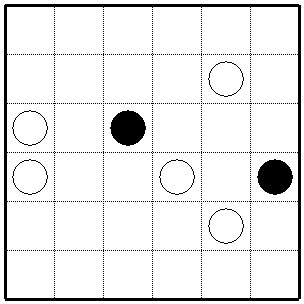
|
|
上の説明で引けた線分(水色と青色)が次の図です。 ここで右端の●枡から引かれた線分は緑色の枠の○枡の中央まで引かれましたが○枡の上で線分は曲がれませんので緑色の枠の枡のもうひとつ左側まで線分が伸びます。 一方左端の○枡の上に引かれた線分は○枡の隣の枡の少なくとも一方では曲がらねばなりませんので黄緑色の枠の枡で右側に曲がった線分が引けます。 The line drawn in the above explanation (light blue and blue) is the next figure. Here, the line segment drawn from the rightmost ● cell was drawn to the center of the green frame ○ cell, but the line segment can not bend on the ○ measure, so this line segment extend to the other left side of the green frame cell. On the other hand, the line segment drawn on the leftmost ○ cell must be bent at least on one side of the cell next to the cell, so a line segment that is bent to the right with a yellow-green frame can be drawn. |
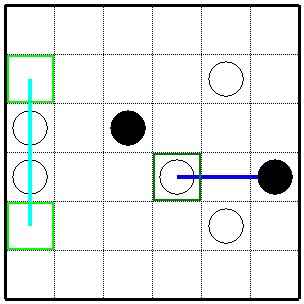
|
|
線分が確定できたものです。(緑色と黄緑色の線分) 次は中央付近の●枡に注目します。●枡から引かれた線分は隣の枡では曲がれませんので下に延びる線分は引けませんので上に延びる線分が決まります。 また左方向は二つ先の枡には既に縦に突き抜けた線分が確定していますので左方向に延びる線分も引けず、右方向の線分が決まります。 下から2番目の枡にある紫色の枠の○枡ではこの上の枡に横方向に貫通した線分が確定していますので縦方向の線分は引けず、横方向の線分が決まります。 The line segment has been confirmed. (Green and yellow-green line segments) Next, pay attention to the ● cell near the center. A line drawn from a ● cell cannot bend at the next cell, so a line extending downward cannot be drawn. Therefore the line extending upward is determined. Also, in the left direction, the line segment that has penetrated vertically has already been determined in the two cells ahead, so the line segment extending to the left can not be drawn, and the line segment in the right direction is determined. In the purple framed ○ cell in the second cell from the bottom, the line segment penetrating in the horizontal direction is fixed to the cell above it, so the vertical line segment can not be drawn and the horizontal line segment is determined . |
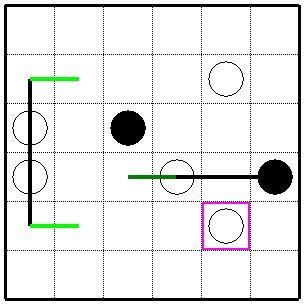
|
|
前の説明で決まったのが紫色の線分です。 もう一度右端の●枡を見てみますと、下向きの線分を引くには下の枡に左から線分が引かれていて長さが足りません。従って上向きの線分が決まります。 また中央付近の赤い枠の枡では右側の○枡を通り抜けてきた線分が曲がらねばいけませんが上向きには曲がれません。したがってここでは下に曲がります。 The purple line segment was determined in the previous explanation. If you look at the rightmost ● cell again, to draw a downward line segment, the other line is drawn from the left to the lower cell and the length is not enough. Therefore, the upward line segment is determined. Also, in the box with a red frame near the center, the line segment passing through the ○ cell on the right must turn, but it cannot turn upward.Therefore, turn down here. |
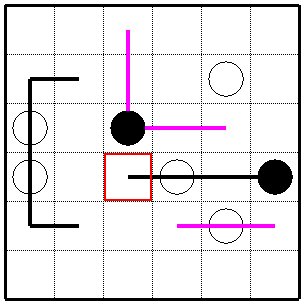
|
|
前の説明で決まったのが赤色の線分です。 ここまで決まったところで水色の枠の枡に注目すると、この枡に引かれた左側からの線分は上に曲がるしかありませんので上向きの線分が引かれ、さらに上の枡が○枡ですので貫通してもうひとつ上の枡まで伸びます。 また青色の枠の枡に左から引かれた線分は下に曲がり、その先盤面の左へとまがります。 The red line segment was decided in the previous explanation. Attention is paid to the cell with a light blue frame when it is decided so far, and the line segment from the left side drawn to this cell can only be bent upward, so the upward line segment is drawn. Furthermore, since the upper cell is a ○ cell, it penetrates and extends to another upward cell. In addition, the line drawn from the left to the cell with a blue frame bends downward, and then turns to the left of the board. |
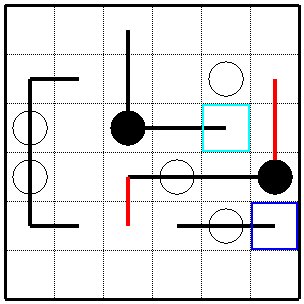
|
|
前の説明で決まったのが水色と青色の線分です。 緑色の枠の枡に注目してみます。右側の○枡から延びてきた線分はここで下に曲がるか左に延びるかの選択肢がありますが、下に曲がると小ループができてしまいますので引けません。 従って左に延びる線分が決まります。 また黄緑色の枠の枡の線分はそのまま左へと伸びます。 The light blue and blue line segments were determined in the previous explanation. Let's pay attention to the green frame. The line segment that extends from the ○ cell on the right side has the option of turning down or extending to the left here, but if you turn down, a small loop will be created and you can not draw it.Therefore, the line extending to the left is determined. In addition, the line segment of the cell in the yellow-green frame extends to the left as it is. |
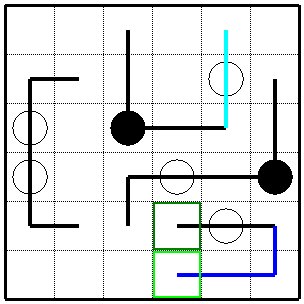
|
| あとは線分の端を伸ばせる方向が1か所のものを伸ばして繋いで行けば完成するはずです。 After that, if you can stretch the end of the line segment in one place and connect it, it should be completed. |
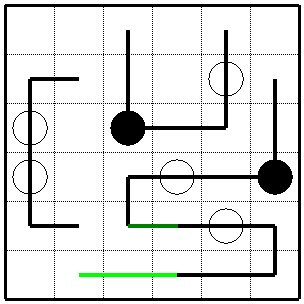
|
| これが正解です。 This is the correct solution. |
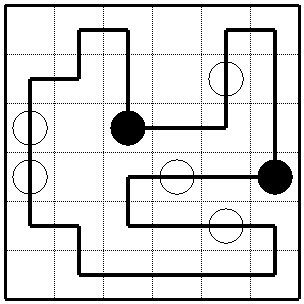
|
|
次にいくつかのパターン(手筋)を紹介しておきます。なぜこうなるかを考えてみると良いでしょう。 次の図の左上のように○枡が三つ並んでいれば並び方向と直行した線分が決まります。(赤色の線分です) 右側のように●枡二つ並んでいれば 並び方向で●枡の無い方向に線分が決まります。(黄緑色の線分です) 左下のように●枡一つと○枡が二つ並んでいれば図のように線分が決まります。(青色の線分です) Next, I will introduce some patterns to solve. It's a good idea to consider why this happens. As shown in the upper left of the following figure, if there are three ○ cells, the straight line segment whose direction is perpendicular to the arrangement are determined.(It is a red line segment) As shown on the right, if there are two cascades of ●, the line segment will be determined in the direction of arrangement but there are no ● cascades. (Yellow-green line segment) If one ● cell and two ○ cell are lined up as shown in the lower left, the line segment is determined as shown in the figure. (Blue line segment) |
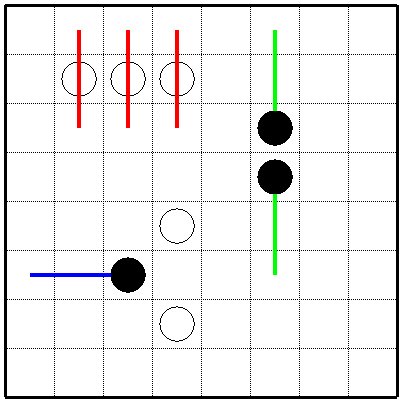
|
|
次の図の左側のように●枡二つと○枡が一つ配置されていれば右側の青い線分のようにが引けます。 これ以外にもいろいろな手筋があります。 As shown on the left side of the following figure, if two ● and one ○ are arranged, they can be drawn as the blue line on the right. There are many other ways to do this. |
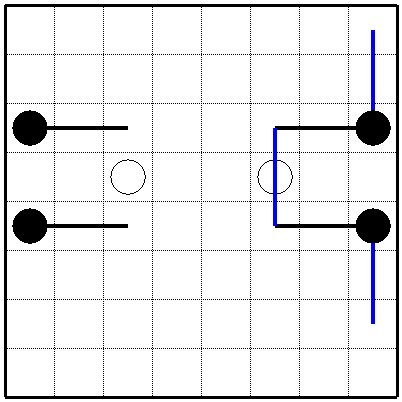
|
2020.3.2修正
2010.6.13作成
鴈野さんちのHomePage Top.
ご感想などは鴈野 敏生 まで。 2020.3.2 Modified
2010.6.13 First edition
Jump to top of Karino's HomePage.
mail to T.Karino